
In at the very beginning
Celebrating the people who invented the cabin air filter
Given that they are now installed as standard equipment in every vehicle in the world, it is hard to imagine there was ever a time before cabin air filters. Yet they have only existed since 1989. In that year, the Mercedes-Benz SL roadster became the world’s first production vehicle to feature a cabin air filter. That product was conceived, developed and produced by Freudenberg, and many millions of the world’s cabin air filters are still supplied from them today.

Who knew?
Back then, no one involved could predict the impact their work would have. All they knew was that they had a great idea and a great development team to make it a reality. They sensed they were working on a major innovation. Back in October last year, 16 of those pioneers gathered in a restaurant in Weinheim, Germany, to reflect on those earliest days and celebrate 30 years of micronAir cabin air filters. Coming from across Germany and several different Freudenberg business units, they brought with them some of the earliest designs and prototypes. In those earliest days, the first filter prototype frames were made of wood.

Fond memories
It didn’t take long before the stories and reminiscences started to flow. Pre-1989, there had only been engine filters. The idea of protecting the vehicle occupants against pollen and other particles was completely new. The innovation originated with a Freudenberg chauffeur, who taped a piece of nonwoven fabric over the air inlet to keep his trousers clean. Once the new product had debuted on the cult SL roadster, other manufacturers scrambled to adopt the new technology. As Sales manager/director Armin Tritsch recalled: “The turning point was when Opel made the cabin air filter standard equipment on their new mass-market Astra model. We knew then that we had a hit on our hands.” Huge orders began rolling in almost overnight, putting enormous pressure on production and logistics processes. Nevertheless, the micronAir team was determined to deliver on time, whatever it took. Once, that commitment involved sending a delivery by helicopter.
Innovation and yet more innovation
Today, Dieter Geiß is Head of HSE-Q at Freudenberg Performance Materials in Kaiserslautern, Germany. In those days, he was one of the team’s product developers: “The biggest challenge we faced was where and how to install the filter in the car.” Dieter Hintenlang is currently responsible for automotive product development at Freudenberg Filtration Technologies: “That’s why we couldn’t simply design the filters in a rectangular shape, but had to design and manufacture asymmetrical contours.” Close customer cooperation has been a cornerstone of micronAir development and production ever since. And the spirit of togetherness that drove the team back then can still be felt today. As Dieter Geiß observed as the evening drew to an end, “In the same constellation, I guess we would be tackling a similarly important task today.” Innovating together, back then, today and into the future.
 automotive filtration insight
automotive filtration insight